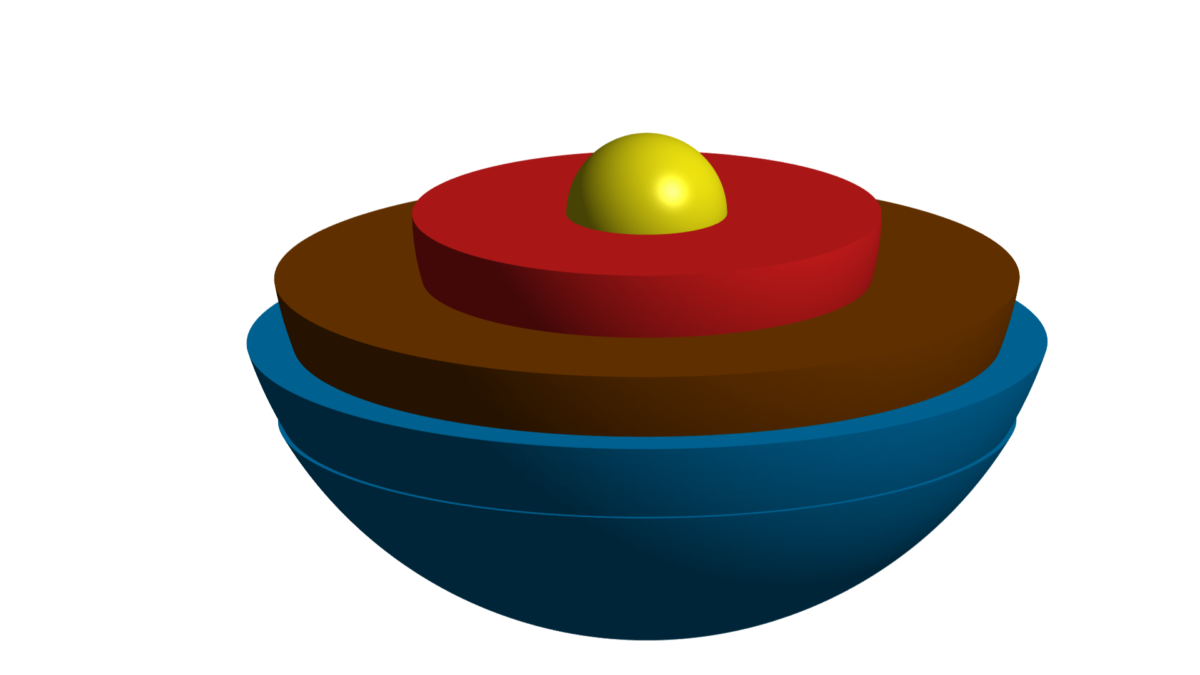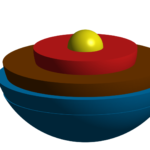
Technichal Specifications
How to use this exercise?
Understanding how the Earth was formed, its inner structure and layers (inner core, outer core, mantle, crust), their dimension, temperature and composition (e.g. liquid, rocks), as well as understanding natural phenomenon (e.g. volcano eruption, earthquakes etc.)
Number of pieces of this exercise
4
General description
The model has two sides:
• On one side, it is spherically shaped, in order to give the idea of the Earth seen from above. No details (like sea, ground etc.) are needed at this stage;
• The other side is much more important to the end of this exercise: here the layered structure of the planet is visible and clear. The layers do not have to have different colours, although this is also highly recommended as it is potentially educative for the students, but they are slightly and gradually raised in order for students to have the idea of where each layer starts. The radius / distance from the centre is to be taken into consideration, as it is representative of the real dimensions of each of them. An indicative radius is more than enough as long as it is clear which layer is bigger than the other. Finally, the inner core is a half showing sphere as this is also the very last layer.
Additional Material
Models used:
License Info
Attribution 4.0 International (CC BY 4.0) https://creativecommons.org/licenses/by/4.0/You are free to:
Share — copy and redistribute the material in any medium or format
Adapt — remix, transform, and build upon the material
for any purpose, even commercially.
Under the following terms:
Attribution — You must give appropriate credit, provide a link to the license, and indicate if changes were made. You may do so in any reasonable manner, but not in any way that suggests the licensor endorses you or your use.
No additional restrictions — You may not apply legal terms or technological measures that legally restrict others from doing anything the license permits.
Learning Specifications
How can the model be used in class?
The model can be used in the classroom as a concrete, visible and touchable example of the Earth and its structure. It is useful during lectures of Physics and Science by giving basic explanations, which are usually taught in Secondary School. At the same time, plate tectonics is a scientific idea that can be used to explain many Earth related phenomena.
An understanding of the layered nature of the Earth is central to understanding plate tectonics and earth science. Geological processes such as the movement of the continents, mountain formation, the worldwide distribution of earthquakes and volcanoes and aspects of evolution (including the production of Australia’s unique flora and fauna and the distribution of fossils) all depend on an understanding of plate tectonics – the very slow movement of solid continental plates across a plastic lower layer.
Questions posed could include:
• How deep is the soil?
• Where are the first rocks?
• Where would you find lava?
• Where does lava come from?
• What’s it like in the centre?
What benefits can its use have?
The model can be used to give a much more concrete idea and perspective of the structure of the Earth. With the different heights of the layers, students can use their touching senses to understand the position and the dimensions of each layer. Moreover, understanding the Earth structure with its huge plates is the basis for understanding several other natural phenomenon that we sometimes experience. For example:
• Volcano’s eruptions;
• Earthquakes;
These largely occur when there is a plate movement. The same structure by layers is a scientific idea developed based on the occurance of natural phenomenon, like the ones already mentioned, rock types and the Earth’s magnetic field.
Can it be used in other subjects?
Science (Natural/Earth).
